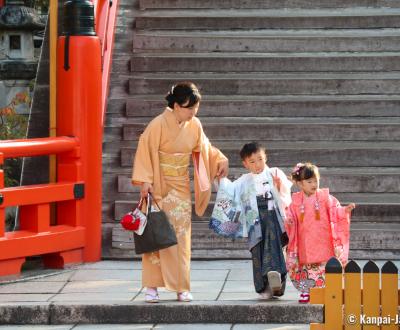Shichi-go-san
👘 The Celebration of 3-5-7 Years Old Children in Japan
Shichi-Go-San is the name of the Japanese custom of celebrating the healthy growth of children of 7, 5 and 3 years old. The children, girls and boys alike, and their family visit together a Shinto shrine to thank the gods and pray to benefit from their continuing protection in the future.
Those who have already been in Japan in autumn 🍁 may have encountered well-dressed parents accompanying their child in a colorful kimono 👘 to the shrine. These happy visitors have witnessed the celebration of Shichi-Go-San (七五三 or 7-5-3), a family celebration that marks one of the traditional rituals in the children’s life.
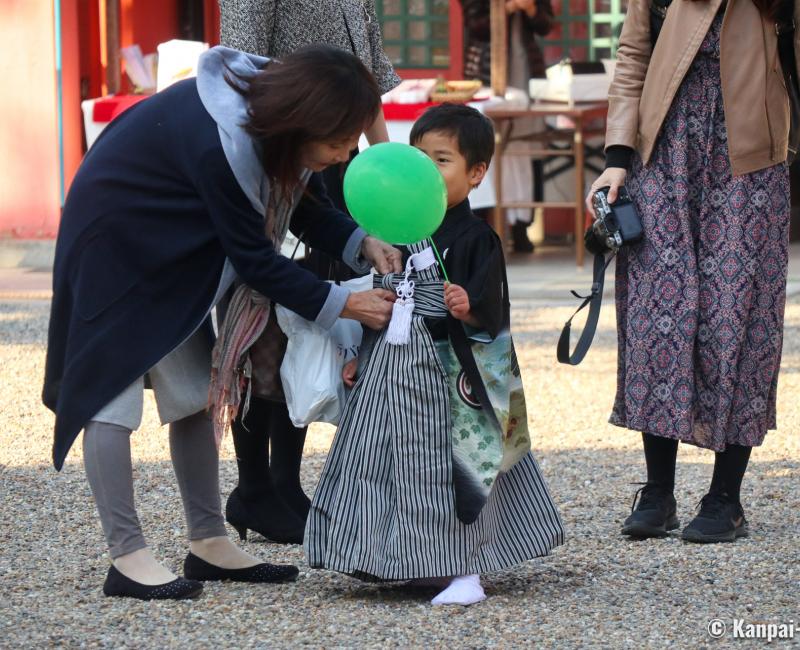
The origins of the custom
This practice was first documented in the Heian period’s aristocracy. Over the centuries, it gradually spread to the warriors’ class, then to the commoners.
Several explanations coexist about the time of the year this celebration takes place. The most common states its beginning was in 1681, on the 15th day of the 11th month when the hakama no gi ceremony, to pray for shogun Tokugawa Tsunayoshi’s first son’s health, was held.
Other explanations suggest that the 11th month of the lunar calendar marked the end of the harvests and the necessity to thank the gods, as well as renewing vows of prosperity and health, especially for children. The fifteenth day of the eleventh month of the former lunar calendar was thus renowned for being a day without demons, an auspicious day favoring all undertakings.
It was during the Meiji era (1868-1912) that the date of November 15 was officially set in the Gregorian calendar, and that its current name Shichi-Go-San was decided. Nowadays, however, the celebration can take place near mid-November, on a non-working day or a holiday, without sticking to November 15 and with a great flexibility to adapt to the parents’ possibilities of taking a day off.
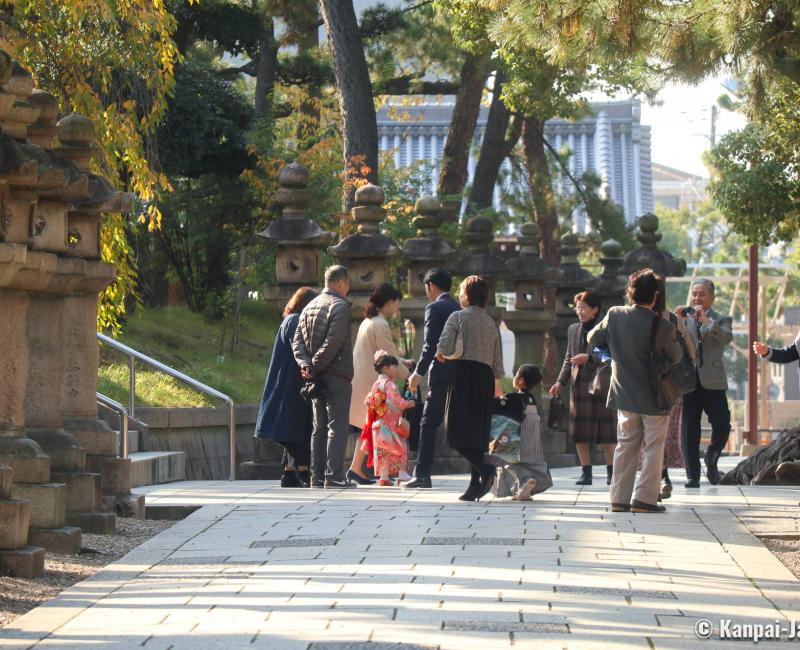
Why 7, 5 and 3 years old?
The ages celebrated used to be considered critical for children’s growth. Moreover, the choice of odd numbers reflects the influence of Chinese philosophy in which they are considered auspicious.
There are many variations in the celebration of Shichi-Go-San, depending on the children’s age and the region, but as a general rule, girls celebrate at 3 and 7 years old, and boys at 3 and 5 years old. The three celebrations have distinctive meanings:
- The 3 years celebration or kamioki no gi (髪置きの儀), originates from the habit of shaving the youngest ones’ hair during the Edo Period, of girls as well as for boys. After this day, children’s hair was let growing.
- The 5 years celebration or hakama no gi (袴儀), is the first time for boys to wear a hakama, the large "trousers" usually worn by grown-up men.
- The 7 years celebration or obitoki no gi (帯解きの儀) or himotoki no gi (紐解の儀) is the first time girls can wear a large obi belt like grown-up women.
In principle, the ceremony is held according to the traditional Japanese counting age system kazoedoshi (数え年, “counted years”) or East Asian age reckoning: the child is already one year old at birth and gets 1 year older at each New Year’s day. However, there is a growing trend of celebrating Shichi-Go-San at the "real" age, according to the Gregorian calendar, mainly for convenience.
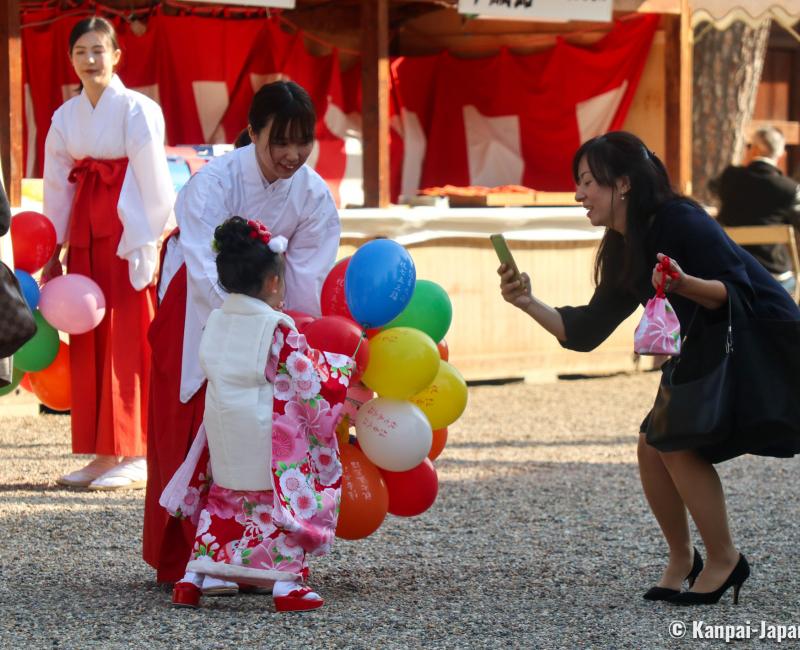
How to celebrate Shichi-Go-San?
Parents, and sometimes also the grandparents, take their 3-, 5- or 7-years old children to the Shinto shrine. This visit to the shrine for Shichi-Go-San (Shichi-Go-San mode 七五三詣で) usually takes place at the shrine to which the family is affiliated, in their neighborhood or region of origin. Children are dressed in colorful kimonos and the family come to bow before the shaden, the pavilion where their tutelary god (ujigami 氏神) is enshrined. Beside prayers, it is the occasion for long commemorative photo sessions, with the family as well as passersby enchanted by the view of children in beautiful attire.
A proper ceremony consists in going to the shrine to make an offering to the deity, usually a sasaki branch decorated with tamagushi (玉串) paper stripes, directly or through the kannushi (神主), the Shinto priest in charge of the sanctuary.
The Shinto ceremony generally includes the following steps:
- The kannushi proceeds to a ritual purification of the attendants (children and families).
- He then reads aloud the names of the children in front of the deity, for about thirty minutes (duration may vary according to the number of children).
- The children, or the kannushi, offer a tamagushi branch each.
- The miko (巫女), young women who assist the priest, then perform a kagura (神楽) traditional dance while ringing small bells.
- Lastly, they offer gifts to the children.
The ceremony can end by a family feast organized by the shrine, in the kaiseki style cuisine, provided additional fees.
As a matter of fact, the ceremony incurs expenses (average price of ¥10,000/ ~US$64.13 per child). It is paid with an offering named hatsuhoryo (初穂料) consisting of cash in a specific enveloped inscribed with the child’s name.
Many shrines offer 7-5-3 services including the lending of the kimono, the child’s dress up, the Shinto ceremony and a photo session, starting from about ¥23,000 (~US$147.50).
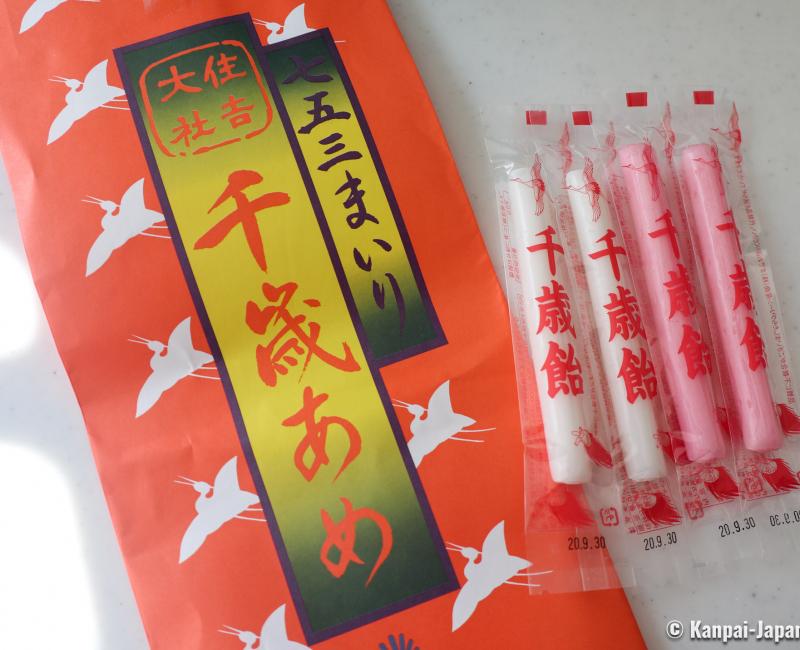
What are the gifts offered to children?
Children are naturally the focus of the celebration and consequently receive several gifts to mark the significant event. The presents can be:
- Omamori (お守り) lucky-charms,
- A hamaya (破魔矢) good-luck arrow that is said to ward off misfortune and attract happiness, an item that can also be offered on the New Year and for Kodomo no hi,
- Small toys and games, such as balls, etc.
But the iconic 7-5-3 gift is a type of hard candy, the chitose ame (千歳飴), whose name means the "1,000 years candy". It comes as a long cylinder (some can be 1 meter long!) made of syrup and sugar, auspiciously colored in white and red. The miko Shinto priestesses wrap up the candies using bags ornamented with the shrine’s colors, and the number of chitose ame vary according to the age of the child. Candy bags are moreover decorated with two types of patterns:
- The tsurukame (鶴亀), the crane and the turtle facing each other, as symbol of longevity,
- The shochikubai (松竹梅), the pine tree, the bamboo, and the plum tree, respectively associated to perseverance, integrity, and modesty.
The shape of the candies, as well as the ornamentation of the wrappings represent the wish that children live a long life and develop essential human qualities.
These candies are said to have been created in the middle of Edo period in Asakusa. Their shapes and colors may of course vary according to the regions.
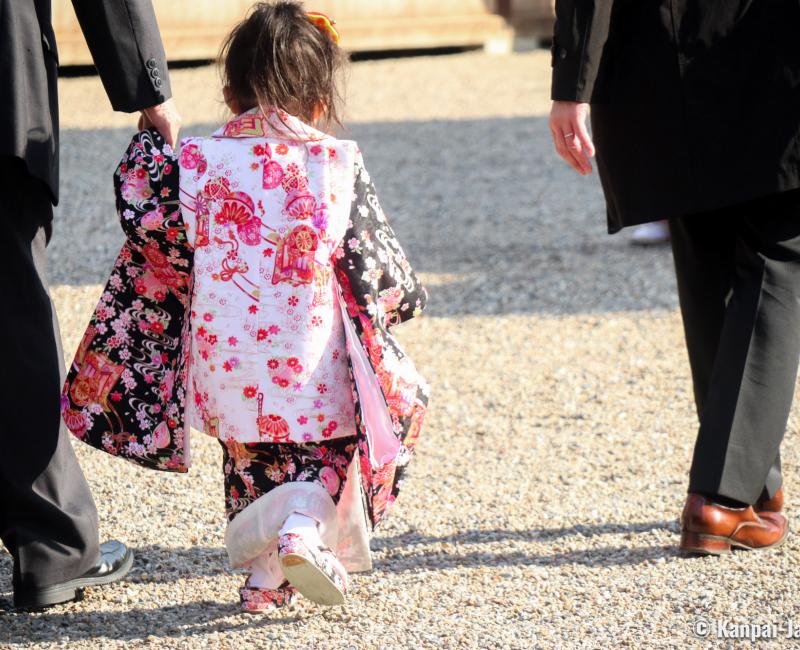
The best shrine to attend to Shichi-Go-San?
A visit on one of the nearest weekends to November 15 maximizes the chances to meet families for Shichi-Go-San. The celebration takes place in any shrine, but it can be better to select an important one to better enjoy this typically Japanese tradition and admire the children’s beautiful clothing under the autumn foliage. We particularly recommend:
- Meiji-jingu, near Harajuku in Tokyo,
- Hie-jinja, in Akasaka in Tokyo, and,
- The unfairly unknown Tomioka Hachiman-gu, in Tokyo's Koto ward.
There are also beautiful places in Kansai area such as:
- Sumiyoshi Taisha, in the south of Osaka, or,
- Heian-jingu, in the north-east of Kyoto.
Nowadays, however, the celebration of Shichi-Go-San is not limited to November 15 anymore, but can take place anytime during the month, depending on the parents’ possibilities to take a day off from work for example. Many shrines also accept the ritual visit outside this period, as it may be difficult to harmonize the imperatives of modern life and ancestral customs 🛂.
Lastly, each family can "customize" the tradition, by organizing a souvenir photo session way before the visit to the shrine, and / or by organizing separately a small family feast. It is also quite common that families just settle for souvenir pictures for 3 years old children, as they are too young to handle spending a full day in kimono without fuss.
The celebration is above all the occasion to take beautiful pictures of the children and the family in formal attires, to offer to the extended family or to friends.

